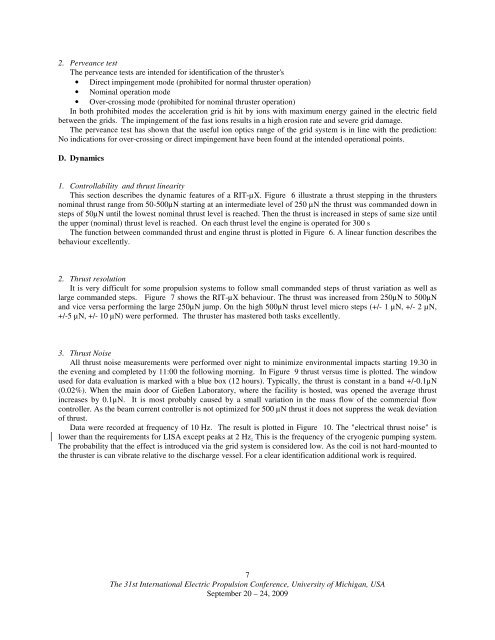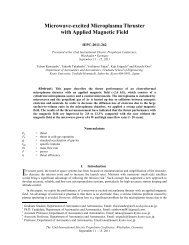Design Development and Test of the RIT-ÁX Mini Ion Engine System
Design Development and Test of the RIT-ÁX Mini Ion Engine System
Design Development and Test of the RIT-ÁX Mini Ion Engine System
You also want an ePaper? Increase the reach of your titles
YUMPU automatically turns print PDFs into web optimized ePapers that Google loves.
2. Perveance test<br />
The perveance tests are intended for identification <strong>of</strong> <strong>the</strong> thruster's<br />
• Direct impingement mode (prohibited for normal thruster operation)<br />
• Nominal operation mode<br />
• Over-crossing mode (prohibited for nominal thruster operation)<br />
In both prohibited modes <strong>the</strong> acceleration grid is hit by ions with maximum energy gained in <strong>the</strong> electric field<br />
between <strong>the</strong> grids. The impingement <strong>of</strong> <strong>the</strong> fast ions results in a high erosion rate <strong>and</strong> severe grid damage.<br />
The perveance test has shown that <strong>the</strong> useful ion optics range <strong>of</strong> <strong>the</strong> grid system is in line with <strong>the</strong> prediction:<br />
No indications for over-crossing or direct impingement have been found at <strong>the</strong> intended operational points.<br />
D. Dynamics<br />
1. Controllability <strong>and</strong> thrust linearity<br />
This section describes <strong>the</strong> dynamic features <strong>of</strong> a <strong>RIT</strong>-µX. Figure 6 illustrate a thrust stepping in <strong>the</strong> thrusters<br />
nominal thrust range from 50-500µN starting at an intermediate level <strong>of</strong> 250 µN <strong>the</strong> thrust was comm<strong>and</strong>ed down in<br />
steps <strong>of</strong> 50µN until <strong>the</strong> lowest nominal thrust level is reached. Then <strong>the</strong> thrust is increased in steps <strong>of</strong> same size until<br />
<strong>the</strong> upper (nominal) thrust level is reached. On each thrust level <strong>the</strong> engine is operated for 300 s<br />
The function between comm<strong>and</strong>ed thrust <strong>and</strong> engine thrust is plotted in Figure 6. A linear function describes <strong>the</strong><br />
behaviour excellently.<br />
2. Thrust resolution<br />
It is very difficult for some propulsion systems to follow small comm<strong>and</strong>ed steps <strong>of</strong> thrust variation as well as<br />
large comm<strong>and</strong>ed steps. Figure 7 shows <strong>the</strong> <strong>RIT</strong>-µX behaviour. The thrust was increased from 250µN to 500µN<br />
<strong>and</strong> vice versa performing <strong>the</strong> large 250µN jump. On <strong>the</strong> high 500µN thrust level micro steps (+/- 1 µN, +/- 2 µN,<br />
+/-5 µN, +/- 10 µN) were performed. The thruster has mastered both tasks excellently.<br />
3. Thrust Noise<br />
All thrust noise measurements were performed over night to minimize environmental impacts starting 19.30 in<br />
<strong>the</strong> evening <strong>and</strong> completed by 11:00 <strong>the</strong> following morning. In Figure 9 thrust versus time is plotted. The window<br />
used for data evaluation is marked with a blue box (12 hours). Typically, <strong>the</strong> thrust is constant in a b<strong>and</strong> +/-0.1µN<br />
(0.02%). When <strong>the</strong> main door <strong>of</strong> Gießen Laboratory, where <strong>the</strong> facility is hosted, was opened <strong>the</strong> average thrust<br />
increases by 0.1µN. It is most probably caused by a small variation in <strong>the</strong> mass flow <strong>of</strong> <strong>the</strong> commercial flow<br />
controller. As <strong>the</strong> beam current controller is not optimized for 500 µN thrust it does not suppress <strong>the</strong> weak deviation<br />
<strong>of</strong> thrust.<br />
Data were recorded at frequency <strong>of</strong> 10 Hz. The result is plotted in Figure 10. The "electrical thrust noise" is<br />
lower than <strong>the</strong> requirements for LISA except peaks at 2 Hz. This is <strong>the</strong> frequency <strong>of</strong> <strong>the</strong> cryogenic pumping system.<br />
The probability that <strong>the</strong> effect is introduced via <strong>the</strong> grid system is considered low. As <strong>the</strong> coil is not hard-mounted to<br />
<strong>the</strong> thruster is can vibrate relative to <strong>the</strong> discharge vessel. For a clear identification additional work is required.<br />
7<br />
The 31st International Electric Propulsion Conference, University <strong>of</strong> Michigan, USA<br />
September 20 – 24, 2009






